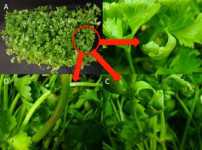Celery Anthracnose A Newly-Identified Fungal Disease

An anthracnose fungus has been identified as the cause of unusual symptoms occurring between 2010 and 2012 in Michigan celery.
Celery anthracnose is caused by the fungus Colletotrichum acutatum. This specific fungus is known to infect other vegetables including pepper, tomato, and spinach. It was first reported as a pathogen on celery in Australia during the 1980s, and was first detected in Michigan in 2010. The common name of this disease is “anthracnose” and is shared with diseases of onions, tomatoes and cucurbits. However, anthracnose in these crops refers to diseases caused by other types of fungi, not the C. acutatum that infects celery.
Symptoms include cupped leaves and twisted petioles with long and thin brown lesions. Other symptoms include development of adventitious roots.
Similar to anthracnose, aster yellows can cause plant twisting and curled leaves. However, foliage of plants affected by aster yellows turns yellow, while foliage of anthracnose-infected plants remains green.
For more on celery anthracnose, including disease resistant varieties and fungicides to use, click here.




